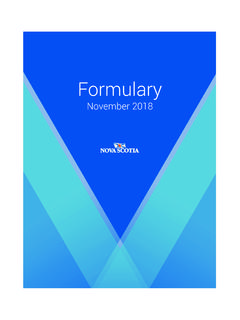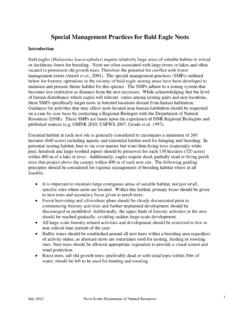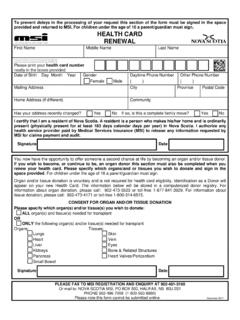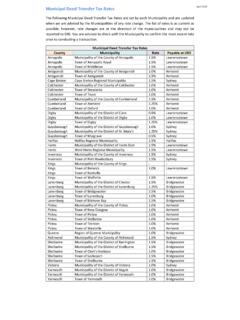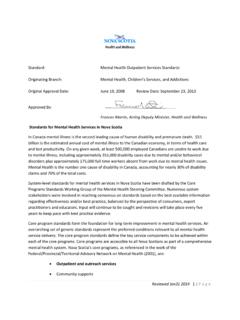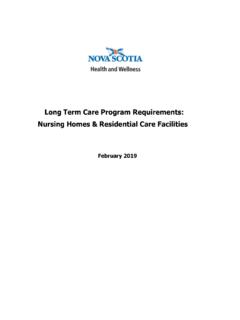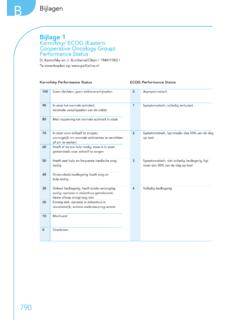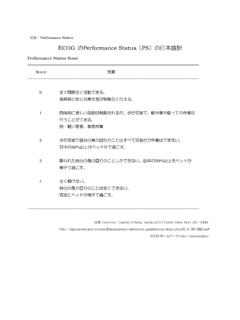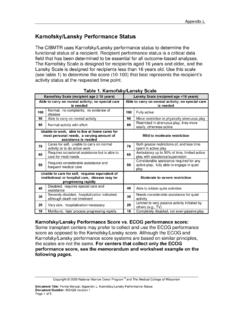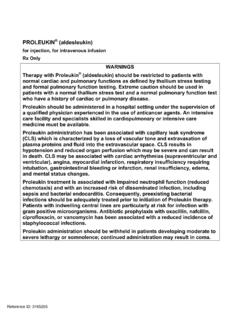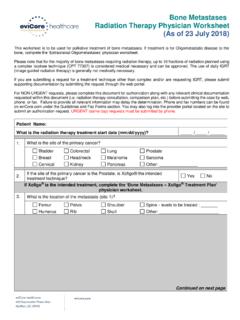Transcription of Appendix III Criteria for Coverage of Exception Status Drugs
1 Appendix III Criteria for Coverage of Exception Status Drugs Coverage of Exception Status Drugs will be approved according to the following Criteria upon review of a prescriber's written request. Forms for Exception Status drug request, which may be used to facilitate the approval process can be found at As an alternative to sending a written request to the Pharmacare office, certain Exception Status Drugs have been assigned Criteria codes. To allow for on-line payment of these Drugs , the Criteria code may be provided by the prescriber on the prescription or confirmed by the pharmacist. The use of these codes offers the prescriber and the pharmacist access to immediate Coverage for patients who clearly meet the Exception Status Criteria . The Criteria codes are indicated within the following Exception Criteria . ABATACEPT (Orencia 125mg/mL Prefilled Syringe and 250mg/vial Injection). For the treatment of severely active rheumatoid arthritis, in combination with methotrexate or other disease- modifying antirheumatic Drugs (DMARDs), in adult patients who are refractory or intolerant to: o Methotrexate (oral or parenteral) at a dose of 20 mg weekly ( 15mg if patient is 65 years of age), or use in combination with another DMARD, for a minimum of 12 weeks.
2 AND. o Methotrexate in combination with at least two other DMARDs, such as hydroxychloroquine and sulfasalazine, for a minimum of 12 weeks. Clinical Notes: For patients who do not demonstrate a clinical response to oral methotrexate, or who experience gastrointestinal intolerance, a trial of parenteral methotrexate must be considered. Optimal treatment response to DMARDs may take up to 24 weeks, however Coverage of a biologic therapy can be considered if no improvement is seen after 12 weeks of triple DMARD use. If patient factors ( intolerance) prevent the use of triple DMARD therapy, these must be described and dual therapy with DMARDs must be tried. Refractory is defined as lack of effect at the recommended doses and for duration of treatments specified above. Intolerant is defined as demonstrating serious adverse effects or contraindications to treatments as defined in product monographs. The nature of intolerance(s) must be clearly documented.
3 Claim Notes: Must be prescribed by a rheumatologist. Combined use of more than one biologic DMARD will not be reimbursed. Initial Approval: 6 months. Renewal Approval: 1 year. Confirmation of continued response is required. Maximum Dosage Approved: o Abatacept Intravenous infusion: 500mg for patients <60 kg, 750mg for patients 60-100 kg and 1000mg for patients >100 kg, given at 0, 2, and 4 weeks then every 4 weeks thereafter. Subcutaneous injection: a single IV loading dose of up to 1,000mg may be given, followed by 125mg subcutaneous injection within a day, then once-weekly 125mg subcutaneous injections. o Subcutaneous injection: a single IV loading dose of up to 1,000mg may be given, followed by 125mg subcutaneous injection within a day, then once-weekly 125mg subcutaneous injections. NOTE: Exception Status Drugs for drug Assistance for Cancer Patients are indicated by an asterisk (*). December 2019 Appendix III.
4 *ABIRATERONE ACETATE (Zytiga 250mg and 500mg Tablet). ASYMPTOMATIC OR MILDLY SYMPTOMATIC PATIENTS. In combination with prednisone for asymptomatic or mildly symptomatic metastatic CRPC patients after failure of androgen deprivation therapy (including an LHRH agonist/antagonist or orchiectomy) who have not received prior chemotherapy for metastatic CRPC and have ECOG PS 0 or 1. Abiraterone would be an alternative to enzalutamide and not sequential therapy in this asymptomatic or mildly symptomatic patient population. SYMPTOMATIC (POST-DOCETAXEL CHEMOTHERAPY) PATIENTS. In combination with prednisone for metastatic CRPC patients with ECOG PS of 0-2 and progression after previous treatment with docetaxel. Abiraterone would be an alternative to enzalutamide and not sequential therapy in this symptomatic post docetaxel chemotherapy setting. RETREATMENT. Use of abiraterone in the post-docetaxel setting is not permitted if previously used in the pre-chemotherapy setting.
5 ABOBOTULINUMTOXIN-A (Dysport Therapeutic 300U and 500U Vial). For the treatment of cervical dystonia (spasmodic torticollis) in adults. For the treatment of upper and lower limb focal spasticity in adults. For the treatment of lower limb spasticity in pediatric patients 2 years of age and older. ACAMPROSATE (Campral 333mg Tablet). For treatment in patients who have been abstinent from alcohol for at least four days and who have contraindications to naltrexone ( , acute hepatitis, liver failure or currently receiving opioids). ACLIDINIUM BROMIDE (Tudorza Genuair 400mcg powder for Inhalation). For the treatment of moderate to severe chronic obstructive pulmonary disease (COPD) as defined by spirometry;. OR. For the treatment of COPD in patients with an inadequate response to short acting bronchodilators. Combination therapy with a long-acting beta-2 agonist /inhaled corticosteroid (LABA/ICS) and a long acting anticholinergic (LAAC) inhaler will be considered in patients with: moderate to severe COPD, as defined by spirometry, a history of COPD exacerbation(s) and an inadequate response to LABA/ICS or LAAC.
6 Clinical Notes: Moderate to severe COPD is defined by spirometry as a post bronchodilator FEV1 < 60% predicted and FEV1/FVC ratio of < Spirometry reports from any point in time will be accepted. If spirometry cannot be obtained, reasons must be clearly explained and other evidence of COPD severity provided, , Medical Research Council (MRC) Dyspnea Scale Score of at least Grade 3. MRC Grade 3 is described as: walks slower than people of same age on the level because of shortness of breath from COPD or has to stop for breath when walking at own pace on the level. Inadequate response to short acting bronchodilators is defined as persistent symptoms, , MRC of at least Grade 3, after at least 2 months of short acting bronchodilator at the following doses*: o 8 puffs per day of short acting beta-2 agonist; or NOTE: Exception Status Drugs for drug Assistance for Cancer Patients are indicated by an asterisk (*). December 2019 Appendix III.
7 O 12 puffs per day of ipratropium; or o 6 puffs per day of ipratropium plus salbutamol combination inhaler. * Inadequate response to LABA/ICS or LAAC is defined as persistent symptoms after at least 2 months of therapy. COPD exacerbation is defined as an increase in symptoms requiring treatment with antibiotics and/or systemic (oral or intravenous) corticosteroids. Notes: Coverage for LABA and LAAC as two separate inhalers will not be considered. Inhalers which combine a LABA/LAAC are also available as ESD benefits. These products have their own Criteria which are listed in the NS Formulary. ACLIDINIUM/FORMOTEROL (Duaklir Genuair 12 g/400 g metered dose for Inhalation). For the treatment of moderate to severe chronic obstructive pulmonary disease (COPD), as defined by spirometry, in patients with an inadequate response to a long-acting beta-2 agonist (LABA) or long-acting anticholinergic (LAAC). Clinical Notes: Moderate to severe COPD is defined by spirometry (post-bronchodilator) FEV1 < 60% predicted and FEV1/FVC.
8 Ratio of < Spirometry reports from any point in time will be accepted. If spirometry cannot be obtained, reasons must be clearly explained and other evidence regarding COPD severity must be provided for consideration ( Medical Research Council (MRC) Dyspnea Scale score of at least Grade 3). MRC Grade 3 is described as: walks slower than people of same age on the level because of shortness of breath (SOB) from COPD or has to stop for breath when walking at own pace on the level. Inadequate response is defined as persistent symptoms after at least 2 months of long-acting beta-2 agonist (LABA) or long-acting anticholinergic therapy (LAAC). ADALIMUMAB (Humira 40mg/vial Injection). See Anti-Tumor Necrosis Factor (TNF) Agents ADEFOVIR DIPIVOXIL (Hepsera 10mg Tablet). In combination with lamivudine in patients who: o Have developed failure to lamivudine (increase in HBV DNA of 1 log10iu/mL over the nadir measured on two separate occasions within an interval of at least one month, after the first 3 months of lamivudine therapy); AND.
9 O When failure to lamivudine is not due to poor adherence to therapy. Coverage approved for 1 year. *AFATINIB DIMALEATE (Giotrif 20mg, 30mg, 40mg Tablet). For first line treatment of patients with EGFR mutation positive advanced or metastatic adenocarcinoma of the lung and with an ECOG performance Status 0 or 1. NOTE: Exception Status Drugs for drug Assistance for Cancer Patients are indicated by an asterisk (*). December 2019 Appendix III. *ALECTINIB (Alecensaro 150mg Capsule). For the first line treatment of patients with locally advanced or metastatic anaplastic lymphoma kinase (ALK). positive non-small cell lung cancer (NSCLC). For the treatment of patients with locally advanced or metastatic anaplastic lymphoma kinase (ALK) positive non- small cell lung cancer (NSCLC) who have disease progression on, or intolerance to crizotinib. Claim Notes: Patients should have a good performance Status and treatment should be continued until disease progression or unacceptable toxicity.
10 If alectinib is chosen as first-line therapy, ceritinib is not funded as a subsequent line of therapy. Alectinib is not funded following two prior ALK inhibitor therapies ( crizotinib followed by ceritinib). Claims for Alecensaro 150mg capsule that exceed the maximum claim amount of $9, must be divided and submitted as separate transactions using the DIN first and then the following PIN: o 00904400. ALEMTUZUMAB (Lemtrada 12 (10mg/mL) concentrated solution for IV infusion in single-use vials). For the management of adult patients with relapsing-remitting multiple sclerosis (RRMS), with active disease defined by clinical and imaging features, who have had an inadequate response to interferon beta or other disease-modifying therapies, if the following clinical Criteria are met: o At least two attacks (first episode or relapse) in the previous two years, with at least one attack in the previous year;. o At least one relapse while on at least six months of a disease modifying therapy within the last 10 years.
